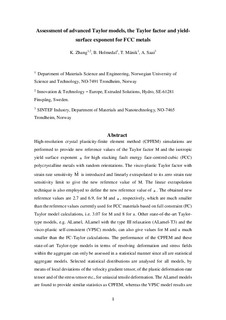| dc.contributor.author | Zhang, Kai | |
| dc.contributor.author | Holmedal, Bjørn | |
| dc.contributor.author | Manik, Tomas | |
| dc.contributor.author | Saai, Afaf | |
| dc.date.accessioned | 2020-02-07T12:47:21Z | |
| dc.date.available | 2020-02-07T12:47:21Z | |
| dc.date.created | 2019-04-10T20:48:18Z | |
| dc.date.issued | 2019 | |
| dc.identifier.citation | International journal of plasticity. 2019, 114 144-160. | nb_NO |
| dc.identifier.issn | 0749-6419 | |
| dc.identifier.uri | http://hdl.handle.net/11250/2640441 | |
| dc.description.abstract | High-resolution crystal plasticity-finite element method (CPFEM) simulations are performed to provide new reference values of the Taylor factor M and the isotropic yield surface exponent for high stacking fault energy face-centred-cubic (FCC) polycrystalline metals with random orientations. The visco-plastic Taylor factor with strain rate sensitivity is introduced and linearly extrapolated to its zero strain rate sensitivity limit to give the new reference value of M. The linear extrapolation technique is also employed to define the new reference value of . The obtained new reference values are 2.7 and 6.9, for M and , respectively, which are much smaller than the reference values currently used for FCC materials based on full constraint (FC) Taylor model calculations, i.e. 3.07 for M and 8 for a. Other state-of-the-art Taylor-type models, e.g. ALamel, ALamel with the type III relaxation (ALamel-T3) and the visco-plastic self-consistent (VPSC) models, can also give values for M and a much smaller than the FC-Taylor calculations. The performance of the CPFEM and these state-of-art Taylor-type models in terms of resolving deformation and stress fields within the aggregate can only be assessed in a statistical manner since all are statistical aggregate models. Selected statistical distributions are analysed for all models, by means of local deviations of the velocity gradient tensor, of the plastic deformation-rate tensor and of the stress tensor etc., for uniaxial tensile deformation. The ALamel models are found to provide similar statistics as CPFEM, whereas the VPSC model results are qualitatively different. The intra-grain analysis for CPFEM demonstrates that the intra-grain interactions are as much important as the local interactions at the grain boundaries. | nb_NO |
| dc.language.iso | eng | nb_NO |
| dc.publisher | Elsevier | nb_NO |
| dc.rights | Attribution-NonCommercial-NoDerivatives 4.0 Internasjonal | * |
| dc.rights.uri | http://creativecommons.org/licenses/by-nc-nd/4.0/deed.no | * |
| dc.title | Assessment of advanced Taylor models, the Taylor factor and yield-surface exponent for FCC metals | nb_NO |
| dc.type | Journal article | nb_NO |
| dc.type | Peer reviewed | nb_NO |
| dc.description.version | acceptedVersion | |
| dc.source.pagenumber | 144-160 | nb_NO |
| dc.source.volume | 114 | nb_NO |
| dc.source.journal | International journal of plasticity | nb_NO |
| dc.identifier.doi | https://doi.org/10.1016/j.ijplas.2018.10.015 | |
| dc.identifier.cristin | 1691480 | |
| dc.description.localcode | © 2019. This is the authors’ accepted and refereed manuscript to the article. Locked until 9.11.2020 due to copyright restrictions. This manuscript version is made available under the CC-BY-NC-ND 4.0 license http://creativecommons.org/licenses/by-nc-nd/4.0/ | nb_NO |
| cristin.unitcode | 194,66,35,0 | |
| cristin.unitname | Institutt for materialteknologi | |
| cristin.ispublished | true | |
| cristin.qualitycode | 2 | |

